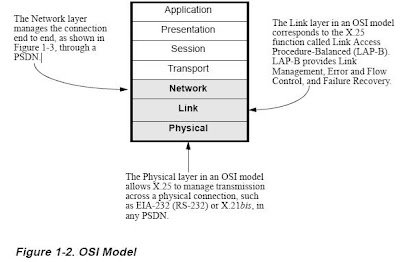The structure of X.25 follows the seven layer OSI model shown in Figure 1-2, and roughly corresponds to the lower three layers: Physical, Link, and Network.

Figure 1-3 illustrates and example network in which the OSI/X.25 Model is identified. The Physical layer applies to the connection from one device to a PSDN. The Link layer (LAP-B) applies to the connections from one device to a second device such as a DTE port to a DCE port.
Link Access Procedure -Balanced (LAPB)
LAP-B is used to manage the transfer of data using frames. Each frame is divided into three specific segments: the header, data, and the trailer. Each segment is further divided into fields as shown in Figure 1-4.

Each field contains information generated by the frames sending device. This information is read by the receiving device to perform the link functions required.
These functions are:
• Link Management. This includes management functions such as accepting or rejecting data frames, disconnecting the link, and setting link response modes. These frames contain commands and responses to coordinate and maintain the link.
• Error Control. LAP-B provides error detection and correction by ensuring that data is transferred across the link accurately. The sending device sequentially numbers each frame it sends and fills in the Frame Check Sequence field with a number it calculates from information derived from the frame contents. The receiving device performs the same calculation and compares it to the frame contents. If the frame data is corrupted, the receiver uses the Link Management frame to tell the sender to resend the corrupted frame. Of course, the corrupted frame is identified by its sequence number. An acknowledgment is sent back to the sending device when a correct frame is received.
• Flow Control. This refers to a process in which the receiving device tells the sender to stop transmitting data when memory (storage or display) limitations are reached. If the receiving device senses that it is nearing its memory limitation, it does not send out the acknowledgment signal to the sender. Once sufficient memory is available, the acknowledgment is send and the sending device continues to send its data.
• Failure Recovery. LAP-B provides failure recovery through the frame sequencing and acknowledgment schema. This allows LAP-B to remember the status of any failed link. Once the failure is corrected, the link will resume sending and receiving data. One interesting consideration to take note of is that many private PSDNs
provide multiple paths for data to follow. In these cases, an alternate path is always available should a link fail. The benefit of these multiple links is that when a call is in progress and the link fails, the call is not disconnected. The alternate route is automatically used and the call continues.

3 comments:
I would like to exchange links with your site www.blogger.com
Is this possible?
Data communication network are super. Thanks for sharing.
Hello, thank you very much for sharing this useful informative for OSI Layers, so if you want to learn more about it OSI Model Layers Definitions, check here!
Post a Comment